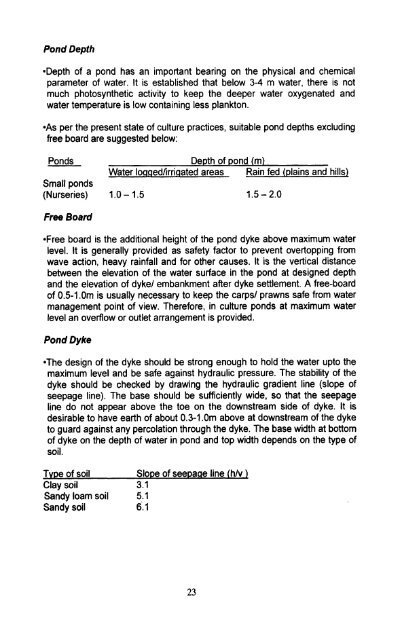Director Ambekar E. Eknath, Ph. D Head, APED J.K. Jena, Ph. D ...
Director Ambekar E. Eknath, Ph. D Head, APED J.K. Jena, Ph. D ...
Director Ambekar E. Eknath, Ph. D Head, APED J.K. Jena, Ph. D ...
Create successful ePaper yourself
Turn your PDF publications into a flip-book with our unique Google optimized e-Paper software.
Pond Depth<br />
.Depth of a pond has an important bearing on the physical and chemical<br />
parameter of water. It is established that below 3-4 m water, there IS not<br />
much photosynthetic activity to keep the deeper water oxygenated and<br />
water temperature is low containing less plankton.<br />
.As per the present state of culture practices, suitable pond depths excluding<br />
free board are suggested below:<br />
Ponds<br />
Small oonds<br />
Depth of pond (m)<br />
Water loaqedlirriqated areas Rain fed (plains and hills)<br />
Free Board<br />
.Free board IS the additional height of the pond dyke above maximum water<br />
level. It is generally provided as safety factor to prevent overtopping from<br />
wave action, heavy ra~nfall and for other causes. It is the vertical distance<br />
between the elevation of the water surface in the pond at deslgned depth<br />
and the elevation of dyke1 embankment after dyke settlement. A free-board<br />
of 0.5-1.0m is usually necessary to keep the carps1 prawns safe from water<br />
management point of view. Therefore, in culture ponds at maximum water<br />
level an ovefflow or outlet arrangement is provided.<br />
Pond Dyke<br />
.The design of the dyke should be strong enough to hold the water upto the<br />
maximum level and be safe against hydraulic pressure. The stability of the<br />
dyke should be checked by drawing the hydraulic gradient line (slope of<br />
seepage line). The base should be sufficiently wide, so that the seepage<br />
line do not appear above the toe on the downstream side of dyke. It is<br />
desirable to have earth of about 0.3-1.0m above at downstream of the dyke<br />
to guard against any percolation through the dyke. The base width at bottom<br />
of dyke on the depth of water in pond and top width depends on the type of<br />
soil.<br />
Tvoe of soil Slope of seepaae line (hlv 1<br />
Clav soil 3.1<br />
sandy loam soil 5.1<br />
Sandy soil 6.1

















